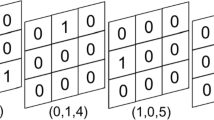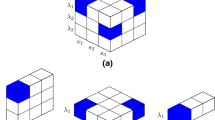Abstract
Using polarization technique in optical code division multiple access, we can schedule the transmission of optical pulses in spatial domain, in addition to the frequency domain and time domain. An optical orthogonal code (OOC) which spreads in these dimensions is called a three-dimensional (3-D) OOC. In this paper, we study 3-D OOC with at most one optical pulse per wavelength/time plane, which have the favorable property that the Hamming auto-correlation is identically equal to 0. An upper bound on the number of codewords for general Hamming cross-correlation requirement is given. A 3-D OCC with at most one pulse per wavelength/time plane and Hamming cross-correlation no more than 1 is shown to be equivalent to a generalized Bhaskar Rao group divisible design (GBRGDD), signed over a cyclic group. Through this equivalence, necessary and sufficient conditions for the existence of GBRGDD of weighted 3, signed over a cyclic group, are derived.
Similar content being viewed by others
References
Abel R.J.R., Buratti M.: Some progress on \((v,\,4,\,1)\) difference families and optical orthogonal codes. J. Comb. Theory A 106(1), 59–75 (2004).
Abel R.J.R., Chan N.H.N., Combe D., Palmer W.D.: Existence of GBRDs with block size 4 and BRDs with block size 5. Des. Codes Cryptogr. 61(3), 285–300 (2011).
Beth T., Jungnickel D., Lenz H.: Design theory. In: Encyclopedia of Mathematics and Its Applications, vol. 78, 2nd edn. Cambridge University Press, Cambridge (1999).
Blake-Wilson S., Phelps K.T.: Constant weight codes and group divisible designs. Des. Codes Cryptogr. 16, 11–27 (1999).
Buratti M.: Cyclic designs with block size 4 and related optimal optical orthogonal codes. Des. Codes Cryptogr. 26, 111–125 (2002).
Buratti M., Pasotti A.: Further progress on difference families with block size 4 or 5. Des. Codes Cryptogr. 56(1), 1–20 (2010).
Chang Y., Fuji-Hara R., Miao Y.: Combinatorial constructions of optimal optical orthogonal codes with weight 4. IEEE Trans. Inf. Theory 49(5), 1283–1292 (2003).
Chang Y., Yin J.: Further results on optimal optical orthogonal codes with weight 4. Discret. Math. 279(1–3), 135–151 (2004).
Chee Y.M., Ge G., Ling A.C.H.: Group divisible codes and their application in the construction of optimal constant-composition codes of weight three. IEEE Trans. Inf. Theory 54(8), 3552–3564 (2008).
Chen K., Zhu L.: Existence of \((q,\,6,\,1)\) difference families with \(q\) a prime power. Des. Codes Cryptogr. 15(2), 167–173 (1998).
Chung F.R.K., Salehi J.A., Wei V.K.: Optical orthogonal codes: design, analysis, and applications. IEEE Trans. Inf. Theory 35, 595–604 (1989).
Colbourn C.J., Rosa A.: Triple Systems. Oxford Mathematics Monographs. Oxford University Press, Oxford (1999).
Dai P., Wang J., Yin J.: Combinatorial constructions for optimal 2-D optical orthogonal codes with AM-OPPTS property. Des. Codes Cryptogr. 1–16 (2012). doi: 10.1007/s10623-012-9733-z.
de Launey W.: Bhaskar Rao designs. In: CRC Handbook of Combinatorial Designs, pp. 299–301. CRC Press, Boca Raton (2007).
Djordjevic I.B., Vasic B.: Novel combinatorial constructions of optical orthogonal codes for incoherent optical CDMA systems. J. Lightwave Technol. 21(9), 1869–1875 (2003).
Etzion T.: Optimal constant weight codes over \(Z_k\) and generalized designs. Discret. Math. 169, 55–82 (1997).
Feng T., Chang Y.: Combinatorial constructions for optimal two-dimensional optical orthogonal codes with \(\lambda = 2\). IEEE Trans. Inf. Theory 57(10), 6796–6819 (2011).
Fuji-Hara R., Miao Y.: Optical orthogonal codes: their bounds and new optimal constructions. IEEE Trans. Inf. Theory 46(11), 2396–2406 (2000).
Gallant R.P., Jiang Z., Ling A.C.H.: The spectrum of cyclic group divisible designs with block size three. J. Comb. Des. 7, 95–105 (1999).
Gao F., Ge G.: Optimal ternary constant-composition codes of weight four and distance five. IEEE Trans. Inf. Theory 57(6), 3742–3757 (2011).
Garg M.: Performance analysis and implementation of three dimensional codes in optical code division multiple access system. Master, Thapar University, Punjab (2012).
Ge G.: On \((g,\,4;\,1)\)-difference matrices. Discret. Math. 301, 164–174 (2005).
Ge G.: Construction of optimal ternary constant weight codes via Bhaskar Rao designs. Discret. Math. 308(13), 2704–2708 (2008).
Ge G., Greig M., Seberry J.: Generalized Bhaskar Rao designs with block size 4 signed over elementary Abelian groups. J. Comb. Math. Comb. Comput. 46, 3–45 (2003).
Ge G., Greig M., Seberry J., Seberry, R.: Generalized Bhaskar Rao designs with block size 3 over finite Abelian groups. Graphs Comb. 23(3), 271–290 (2007).
Hanani H.: Balanced incomplete block designs and related designs. Discret. Math. 11, 255–369 (1975).
Jiang Z.: Concerning cyclic group divisible designs with block size three. Australas. J. Comb. 13, 227–245 (1996).
Jindal S., Gupta N.: Performance evaluation of optical CDMA based 3D code with increasing bit rate in local area network. In: IEEE Region 8 Computational Technologies in Electrical and Electronics Engineering (SIBIRCON), Novosibirsk, Russia, pp. 386–388, 2008.
Kim S., Yu K., Park N.: A new family of space/wavelength/time spread three-dimensional optical code for OCDMA network. J. Lightwave Technol. 18(4), 502–511 (2000).
Li X., Fan P., Shum K.W.: Construction of space/wavelength/time spread optical code with large family size. IEEE Commun. Lett. 16(6), 893–896 (2012).
Li X., Fan P., Suehiro N., Wu D.: New classes of optimal variable-weight optical orthogonal codes with Hamming weights 3 and 4. IEICE Trans. Fundam. Electron. Commun. Comput. Sci. E95–A(11), 1843–1850 (2012).
McGeehan J.E., Motaghian Nezam S.M.R., Saghari P., Willner A.E., Omrani R., Kumar P.V.: Experimental demonstration of OCDMA transmission using a three-dimensional (time–wavelength-polarization) codeset. J. Lightwave Technol. 23(10), 3283–3289 (2005).
Miyamoto N., Mizuno H., Shinohara S.: Optical orthogonal codes obtained from conics on finite projective planes. Finite Fields Appl. 10(3), 405–411 (2004).
Omrani R., Kumar P.V., Elia P., Bhambhani P.: Large families of optimal two-dimensional optical orthogonal codes. IEEE Trans. Inf. Theory 58(2), 1163–1185 (2012).
Ortiz-Ubarri J., Moreno O., Tirkel A.: Three-dimensional periodic optical orthogonal code for OCDMA systems. In: IEEE Information Theory Workshop (ITW), Paraty, Brazil, pp. 170–174, 2011.
Rotman J.J.: Advanced Modern Algebra. Graduate Studies in Mathematics, 2nd edn. American Mathematic Society, Providence (2009).
Sawa M.: Optical orthogonal signature pattern codes with maximum collision parameter 2 and weight 4. IEEE Trans. Inf. Theory 56(7), 3613–3620 (2010).
Wang J., Shan X., Yin J.: On constructions for optimal two-dimensional optical orthogonal codes. Des. Codes Cryptogr. 54, 43–60 (2010).
Wang J., Yin J.: Two-dimensional optimal optical orthogonal codes and semicyclic group divisible designs. IEEE Trans. Inf. Theory 56(5), 2177–2187 (2010).
Wang K., Wang J.: Semicyclic 4-GDDs and related two-dimensional optical orthogonal codes. Des. Codes Cryptogr. 63(3), 305–319 (2012).
Wang X., Chang Y., Feng T.: Optimal 2-D (\(n\times m\), 3, 2, 1)-optical orthogonal codes. IEEE Trans. Inf. Theory 59(1), 710–725 (2013).
Wilson R.M.: An existence theory for pairwise balanced designs. J. Comb. Theory A 13, 220–245 (1972).
Yin J.: Some combinatorial constructions for optical orthogonal codes. Discret. Math. 185, 201–219 (1998).
Zhang H., Zhang X., Ge G.: Optimal ternary constant-weight codes with weight 4 and distance 5. IEEE Trans. Inf. Theory 58(5), 2706–2718 (2012).
Acknowledgments
This work was partially supported by a Grant from University Grants Committee of the Hong Kong Special Administrative Region, China (Project No. AoE/E-02/08).
Author information
Authors and Affiliations
Corresponding author
Additional information
Communicated by J. D. Key.
Rights and permissions
About this article
Cite this article
Shum, K.W. Optimal three-dimensional optical orthogonal codes of weight three. Des. Codes Cryptogr. 75, 109–126 (2015). https://doi.org/10.1007/s10623-013-9894-4
Received:
Revised:
Accepted:
Published:
Issue Date:
DOI: https://doi.org/10.1007/s10623-013-9894-4




